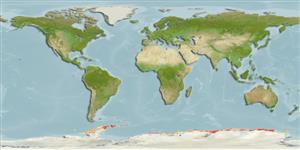>
Perciformes/Notothenioidei (Icefishes) >
Nototheniidae (Cod icefishes) > Trematominae
Etymology: Trematomus: Greek, trematos = hole + Greek, tomo = section, cut (Ref. 45335); tokarevi: Named after Dr. A.K. Tokarev, ichthyologist of the First Soviet Antarctic Expedition (Ref. 11892).
Eponymy: Dr Aleksey K Tokarev (1915–1957) served as ichthyologist on the First Soviet Antarctic Expedition. He died while returning from the Antarctic. (Ref. 128868), visit book page.
More on author: Andriashev.
Issue
The genus Pseudotrematomus is a synonym of Trematomus, which is confirmed by a molecular study to be published (J.-C. Hureau, pers. comm. 08 Jun. 2010).
Environment: milieu / climate zone / depth range / distribution range
Écologie
marin bathydémersal; profondeur 200 - 700 m (Ref. 122792). Deep-water; 60°S - 70°S
Southern Ocean: Oates Land and Shackleton Ice Shelf in East Antarctic, and near the South Orkney and South Shetland Islands.
Taille / Poids / Âge
Maturity: Lm ? range ? - ? cm
Max length : 22.4 cm TL mâle / non sexé; (Ref. 5179)
Description synthétique
Clés d'identification | Morphologie | Morphométrie
Épines dorsales (Total) : 4 - 6; Rayons mous dorsaux (Total) : 35 - 37; Rayons mous anaux: 32 - 33; Vertèbres: 51 - 53. Slender, deep bodied form. Light cinnamon brown with greenish hue above, light below. Body with spots and strands of grayish-brown.
A deep-water species, generally inhabiting deep waters and less frequently in shallow waters. Collected from flat bottom without big shelters, like rocky niches and seaweeds (Ref. 122792).
Life cycle and mating behavior
Maturité | Reproduction | Frai | Œufs | Fécondité | Larves
Dewitt, H.H., P.C. Heemstra and O. Gon, 1990. Nototheniidae. p. 279-331. In O. Gon and P.C. Heemstra (eds.) Fishes of the Southern Ocean. J.L.B. Smith Institute of Ichthyology, Grahamstown, South Africa. (Ref. 5179)
Statut dans la liste rouge de l'IUCN (Ref. 130435: Version 2024-1)
Menace pour l'homme
Harmless
Utilisations par l'homme
Pêcheries: sans intérêt
Outils
Articles particuliers
Télécharger en XML
Sources Internet
Estimates based on models
Preferred temperature (Ref.
123201): -1.4 - 0.8, mean -0.4 °C (based on 100 cells).
Phylogenetic diversity index (Ref.
82804): PD
50 = 0.5005 [Uniqueness, from 0.5 = low to 2.0 = high].
Bayesian length-weight: a=0.00537 (0.00279 - 0.01033), b=3.24 (3.08 - 3.40), in cm total length, based on LWR estimates for this Genus-body shape (Ref.
93245).
Niveau trophique (Ref.
69278): 3.2 ±0.41 se; based on food items.
Résilience (Ref.
120179): Milieu, temps minimum de doublement de population : 1,4 à 4,4 années (Preliminary K or Fecundity.).
Fishing Vulnerability (Ref.
59153): Low vulnerability (12 of 100).
